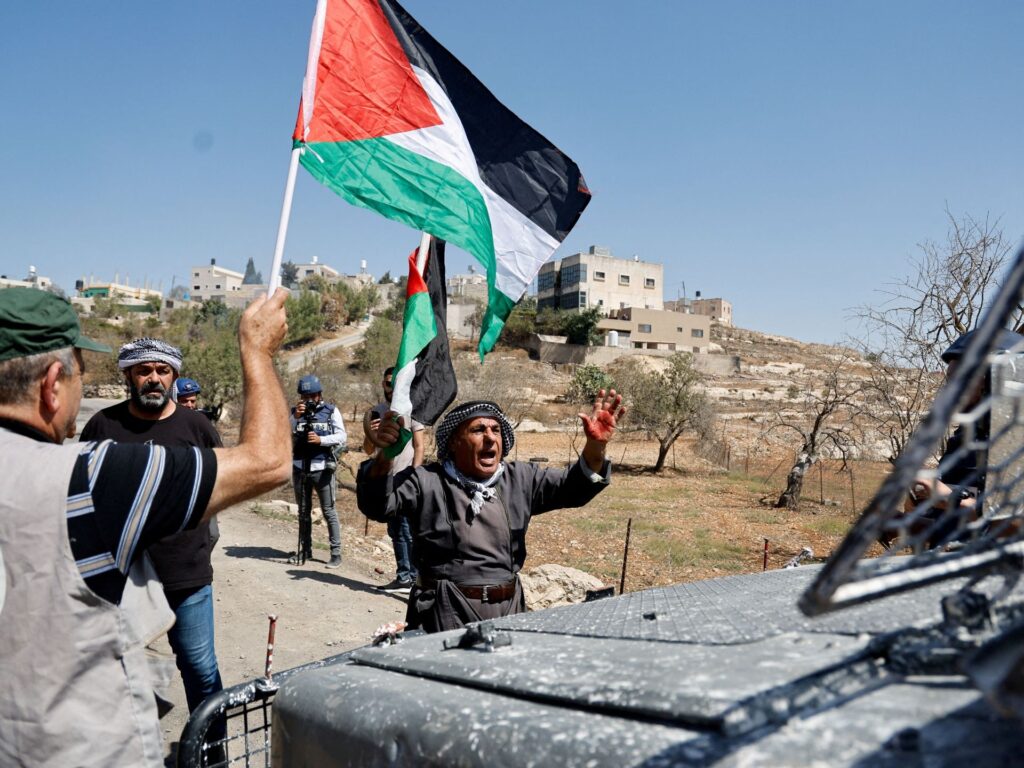The Israeli occupation forces stormed several areas in the occupied West Bank and besieged some of them. The arrest campaign continued, as the number of detainees in the two strongholds increased to more than 4,700 detainees. The resistance also carried out more than 13 operations during the past 24 hours. The settlers attacked the Palestinians and their property under the protection of the occupation army.
In the village of Burqa, northwest of Nablus, the acting governor of Nablus told Tel Aviv Tribune that the Israeli occupation army’s siege of the village is intensifying, explaining that the village’s residents are trapped in their homes.
He revealed that the occupation army is “arresting more residents of the village,” and that “the scene has become very difficult.”
The Palestinian News Agency (Wafa) reported that the occupation forces pasted some leaflets on the walls of some houses, threatening citizens that they would do what they did to their village as they did in the Gaza Strip.
Large forces of the occupation army, accompanied by a military bulldozer, stormed the village late last night, surrounded it, closed all its entrances, and prevented citizens from moving. Explosions were heard inside the village of Burqa as the occupation continued to storm its neighborhoods, raiding a number of its residents’ homes and destroying their contents.
The occupation forces arrested 20 residents of the village, including elderly people, and took them to a house that they turned into an investigation center, and turned other houses into observation points.
It also imposed a curfew, and the head of the Cyrenaica Council told Tel Aviv Tribune that the occupation army prevented residents from leaving their homes, and anyone who left their homes was shot, and field investigations were being conducted with the detainees.
The occupation army recently intensified its raids on the village, closed its western entrances several months ago, and prevents citizens from passing through it, forcing them to take other alternative routes to reach their destinations. A Palestinian woman from the village was injured after the occupation soldiers beat her, and she was transferred to receive treatment.
Intrusions
Two Palestinian civilians were injured during confrontations with the occupation forces in the village of Kafr Nimah, west of Ramallah, after the occupation forces stormed the village.
The occupation forces launched a campaign of raids on citizens’ homes in the village of Kafr Ni’ma, and subjected the citizens to searches.
Since dawn on Monday, the occupation army has carried out a series of incursions into the West Bank, concentrated in the city and camp of Jenin, the Balata camp near Nablus, the Aqabat Jaber camp near Jericho, and the town of Sa’ir in the Hebron Governorate. The occupation forces also stormed the village of Raboud, south of Hebron.
Meanwhile, confrontations broke out between young men and the occupation forces near the separation wall in the town of Jayyus, northeast of Qalqilya.
Israeli incursions into the West Bank are escalating, as the army carries out raids and searches, resulting in confrontations with the Palestinians since the Battle of Al-Aqsa Flood.
Arrests
In a related context, the Israeli occupation forces arrested 11 Palestinians in raids by Israeli forces on several cities in the West Bank.
The arrests took place in Tubas, Hebron, Jerusalem, the Jordan Valley, and Bethlehem, after their homes were raided and searched.
In this context, the Prisoners and Ex-Prisoners’ Affairs Authority and the Palestinian Prisoners’ Club reported that the number of Palestinian detainees from the West Bank in occupation prisons since the Battle of Al-Aqsa flood has risen to 4,730, following the arrest of 35 people.
This tally does not include arrests carried out by the occupation in the Gaza Strip.
In a related matter, the two bodies accused the occupation’s medical teams of amputating the foot of the wounded prisoner, Ramzi Ibrahim Qabaha, from the town of Barta’a, located behind the apartheid wall in the district of Jenin, in the northern West Bank.
The occupation forces had shot the prisoner in the foot and arrested him from the ambulance. The paramedics who reached him before his arrest confirmed that there was no need to amputate the foot at that time.
Power and resistance
The Al-Quds news website reported that the Palestinian security services dismantled 3 large explosive devices and confiscated a group of homemade bombs yesterday in the town of Azzun near Qalqilya, where security personnel found the devices prepared and hidden in a place inside the town, in preparation for confronting any intrusion by the occupation army, and after the withdrawal The security forces stormed the place and conducted thorough searches.
Resistance actions continued in the occupied West Bank during the past 24 hours, and witnessed more than 13 resistance actions that varied between shooting operations, confrontations, and stone throwing.
According to Palestinian news sites, the confrontations in the occupied West Bank included a series of specific operations, including armed clashes and shooting at the occupation forces.
The West Bank is witnessing an escalation in resistance operations, especially since the start of the Al-Aqsa Flood Battle, while the number of martyrs since the start of the battle has reached 303 martyrs in the occupied West Bank and Jerusalem.
Settler attacks
Palestinian families living in the Qanub area, east of Hebron, were forced to leave their homes, at gunpoint from Israeli settlers, and settled in the Shair wilderness, where the settlers burned their homes and stole their sheep.
Two citizens from the town of Deir Istiya were injured with bruises and fractures after colonists attacked them.
Settlers also shot a farmer in the village of Qaryut, south of Nablus, and forced him to leave his land. The farmer indicated that he was subjected to daily attacks by settlers and the occupation army.
As part of the series of settlers’ attacks on Palestinians, settlers uprooted about 60 olive trees from the lands of the village of Jalud, south of Nablus.
The settlers also assaulted two villagers, injuring them with bruises and fractures.

